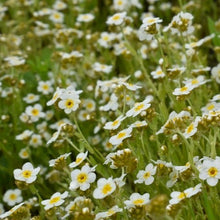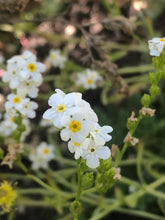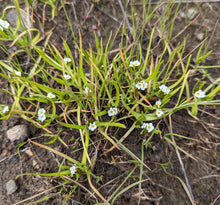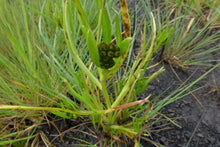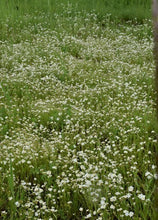
Plagiobothrys figuratus
Fragrant popcorn flower is a self-sowing annual (or biannual) that will effortlessly fill-in gaps between other perennials and shrubs with its showy white and yellow flowers. Closely related to forget me nots (Myosotis), its plentiful, fragrant flowers attract and support native pollinators, unfurling along short leafy stems that rarely grow more than 12” tall. On warm summer days, you’ll be rewarded for planting large swaths of this species by its sweet perfume and bumblebee buddies floating through the air.
This is another species that was historically common, with its largest populations in the Willamette Valley, but is now quite uncommon as its wet meadow habitats have been drained and converted to farm fields and subdivisions.
- Plant type/canopy layer: deciduous, annual/biennial (will self-sow), herbaceous plant
- Size at maturity: 6-15" tall, 6” wide
- Light requirements: full sun, part sun/part shade
- Moisture requirements: moist to wet soil
- Bloom time: May - July
- Growth rate/ease: medium growth rate, easy to grow
- Wildlife support: flowers attract and support butterflies, bees and other insect pollinators; overall plant attracts and support beneficial insects
- Native habitat/range: grows in wet, low-lying areas such as moist fields, open meadows, wet prairies, shallow marshes and occasionally along watercourses and ditches. Portland Plant List - yes.
- Special features & uses: moderately deer resistant; works well in containers; landscape uses include raingardens, bioswales and other wet areas of the habitat garden
Gardening with Fragrant Popcorn Flower: Just give this plant ample moisture and a little bit of real estate and it will effortlessly self-sow create a sweet white-flowering groundcover in sunny moist to wet areas, especially raingardens and bioswales. That said, despite its predilection for wet sites, fragrant popcorn flower can survive in some upland locations if it has sufficient rain and limited competition from other plants. So go ahead and try it in poorly drained yards that dry out in the summer, as well as bioswales and rain gardens. Also works very well in containers.
Try coupling it in a bed with clustered wild rose (Rosa pisocarpa), black twinberry (Lonicera involucrata), Douglas spiraea (Spiraea douglasii), lady fern (Athyrium filix-femina) and other moisture loving wildflowers such as common camas (Camassia quamash), lupine species and western buttercup (Ranunculus occidentale).
Photo Credits 1 & 5 (many flowers, in the wild): © Gail A Baker, some rights reserved (CC-BY)
Photo Credit 2 (flowers close): © Jared Shorma, some rights reserved (CC-BY)
Photo Credit 3 (flowering habit): © Dominic Gentilcore, some rights reserved (CC-BY)
Photo Credit 4 (fruits): © Don Boucher, some rights reserved (CC-BY)





